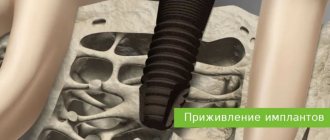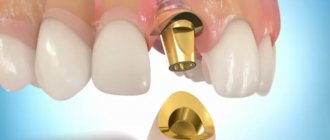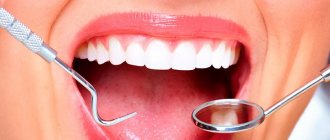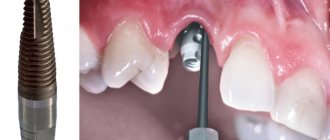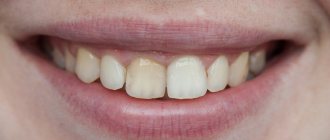It’s a long wait for the artificial root to engraft, then for the formation of a gum ridge and get a beautiful smile in six months. And this is only if it was not necessary to additionally build up bone tissue. Otherwise, the treatment will take twice as long. The prospect is not very bright, you will agree. At the Ilatan Clinic, implant installation is carried out immediately after tooth extraction. This is a reliable method that allows you to minimize interference in the dental system and quickly restore the missing unit. Often, the implant can be immediately loaded with a crown - the patient will immediately receive a new tooth.
When can an implant be installed immediately after tooth extraction?
Indications for emergency implantation are:
- The presence of mobile, damaged teeth and roots that need to be removed;
- single, multiple restorations;
- tooth injury, with the inability to save it;
- fracture, crack of a tooth root;
- perforation of the dental canal during filling.
But installing an implant after tooth extraction is not always possible.
The doctor plans the procedure in advance, and a comprehensive diagnosis is required to assess the possibility of a one-time installation. In case of emergency removal without the necessary examination, the method is not used. In addition, the patient should not have contraindications to implantation and surgical interventions in general.
Good quality and sufficient volume of bone is important. If there is inflammation, a cyst, or any other pathological focus on the root of the extracted tooth, immediate implantation is not performed. Also, the procedure will have to be postponed if the removal was traumatic or the alveolar process was severely damaged.
Branded rehabilitation - for quick recovery
A unique complex of accelerated rehabilitation
- Lymphatic drainage. Biostimulants improve lymph outflow, prevent the formation of edema and hematomas, tighten the facial contour
- PRP plasma lifting. Platelet-rich blood plasma heals, stops the appearance of hematomas, and reduces swelling
- Microcurrent therapy. Low frequency currents relieve facial microspasms and pain, improve metabolism and healing
We work exclusively with premium implants from the leading company Nobel Biocare®. The line of implantation systems allows you to select the necessary implant in any clinical situation, including simultaneous implantation after the removal of anterior or chewing teeth. We provide a lifetime warranty for implantation together with the manufacturer.
Advantages of one-stage implantation
The following advantages are associated with installing an implant after tooth extraction:
- Reducing treatment time;
- minimal trauma - no re-operation or formation of a bed for the implant is required in the bone;
- no need for bone grafting;
- preservation of the natural gum contour;
- the ability to immediately load the titanium root with a prosthesis.
If there are all conditions for immediate implantation, this opportunity should be used. The advantages of the technique of installing an implant in the socket of an extracted tooth are especially relevant in the smile area. The implant is immediately implanted without surgery - the tooth is removed from the socket, and a titanium root is screwed in its place. More often, immediately covering it with a prosthesis.
Lifetime Warranty
We have created all the conditions to exclude medical and technological errors, so without fear we provide a lifetime guarantee for implantation
We work with the best premium implants from the leading company Nobel Biocare®, for which, together with the manufacturer, we provide an indefinite guarantee in the Dr.Levin LifeTime Warranty format . For each installed implant, a passport with a number and series is issued.
Since 2004 we have been the Nobel Biocare® Center of Clinical Excellence in Eastern Europe. This status is available provided that over 10 years of work, the percentage of rejection of implants installed in the clinic is less than 2%.
Disadvantages of one-stage implantation
Installing an implant using a one-step protocol may be against installation, as there may be a higher risk of complications. Even after the most gentle removal, the gums and bone are injured, plaque can accumulate in the socket, leading to inflammation and implant rejection. However, if the procedure was carried out in strict accordance with the protocol, such problems are excluded. The risk of complications and recovery time directly depend on the equipment used and the experience of the implantologist. There is no need to take risks by trusting your health to untested doctors.
There are definitely disadvantages to the technique of installing an implant in the socket of an extracted tooth. The procedure is relatively immediate; the patient still needs to visit the clinic several times to undergo diagnostics and prepare for the intervention. The disadvantages also include high requirements for the quality and volume of bone tissue, and a large list of restrictions.
Computer diagnostics - to eliminate risks
The Center uses a high-precision dental tomograph Sirona Galileos (Germany)
- Determination of the position of the roots of the teeth, the presence of possible inflammatory processes
- Assessment of the condition of the surrounding bone tissue, its structure, density and size
- Identification of anatomically important structures (nerves, vessels, maxillary sinuses) to avoid their damage
Stages of treatment
- Preparation
- collection of anamnesis, examination and examination of the patient for contraindications (laboratory tests), assessment of the condition of the oral cavity and dental apparatus (orthopantomogram, 3D tomography), hygienic cleaning (removal of plaque, tartar). - Implant installation
- the doctor carefully removes the affected tooth in order to minimally injure the alveolar process. Forms a bone bed if the hole is not suitable in size for installing an implant. Screws the titanium root into the prepared hole, fills it with bone chips (for better stabilization of the implant), and sutures the gum. - Temporary prosthetics
- according to the clinical picture, with a one-stage protocol, one-piece or two-piece (classical) implant models can be used. Three types of prostheses are used as an adaptive orthopedic design: removable immediate prosthesis; - lightweight plastic crown;
- complete denture with plastic artificial ones.
- prosthetics with a permanent orthopedic system is performed after complete fusion of the titanium root with the bone. If the implant is implanted using classical technology, it is left for 3-5 months, then loaded with a permanent prosthesis.
A single crown can only be installed on single-rooted units (incisors, canines) that are not subject to heavy loads. In this case, the crown is removed from the bite (made below the dental arch) to eliminate any pressure on the titanium root.
How is the procedure done?
At the first stage, the patient visits the clinic for diagnostics. The blood is submitted to a laboratory for analysis; the analysis takes from one to several days. If you have your own diagnostic unit, the results can be known in a few hours. Afterwards an X-ray examination is carried out. To assess the condition of the jaw, a panoramic X-ray or computed tomography of the jaw is taken and the result is recorded on an information medium. If the patient goes to a third-party clinic or specialized center, the computed tomography scan is issued on a disk with the seal of the medical institution, signature and transcript of the specialist. Printing on film is rarely done, since electronic recording is more informative for the doctor. At the first appointment, the patient and dentist, having all the necessary data, discuss the expected result and which implantation options are most suitable for a particular patient. If during the examination no contraindications are identified, a treatment plan is drawn up that meets the patient’s wishes, then the dentist proceeds to the preparation stage.
In order for dental implantation to be successful immediately after removal, the dentist uses a computer model to predict the outcome of the operation. On the appointed day, the patient’s tooth is removed under anesthesia. An implant is placed in the socket, powdered bone material is added if necessary, and sutures are placed to close the operated area and stabilize the implant.
It is impossible to put a full load on an artificial tooth immediately after implantation, since primary stability can be disrupted. It is recommended not to overheat, hypothermia or physically overexert in the first week after surgery. In the first two months, it is recommended to follow a diet. Eat foods rich in vitamins and minerals, not spicy, salty or sour, as such foods irritate the mucous membrane.
The engraftment process takes from 4 to 6 months. After this time, the dentist will schedule a visit to determine the condition of the implant. When healing is complete, the crown is replaced. If the immediate loading technique was used, then initially a plastic crown is installed on the implant. This material is lighter and more aesthetic, and does not load the implant. But after six months of wearing it, it must be changed to ceramics, metal ceramics or zirconium. If a delayed loading protocol is used, a permanent crown is placed. It is fixed to the implant using an abutment after engraftment. The orthopedic stage completes the implantation process, after which the patient can chew and eat familiar foods.
After all procedures are completed, the patient must visit the dentist twice a year. This is necessary to preserve the implant and maintain stable oral health. During preventive examinations, the patient is recommended to undergo a hygienic teeth cleaning procedure. The plaque that forms in the oral cavity cannot be cleaned with a regular brush, even if all hygiene rules are followed. Professional cleaning helps prevent the accumulation of hard plaque around the implant, removes the yellow bacterial film, makes teeth naturally white, and eliminates microbes that cause gum inflammation. Gum disease directly affects the condition of the implant; in weakened gums, it becomes loose and falls out. Ultrasound cleaning reduces the risk of developing any periodontal diseases and improves the condition of teeth and gums.
Features of the rehabilitation period
After the operation, the implantologist will give detailed recommendations to the patient regarding care, regimen, and nutrition. Since the implantation was gentle, pain is usually mild or absent. Discomfortable sensations, as after a regular removal, go away on their own within 3-5 days.
Scrupulous adherence to medical instructions in the postoperative period ensures rapid and trouble-free healing and prevents the development of complications. Recommendations are conventionally divided into general and medical.
What's included in the price
In our Center the cost of everyone. With one-stage implantation, cases of tooth extraction and implant installation are summarized.
- A case for tooth extraction includes pain relief, the work of a surgeon, restoration of the bone of the socket, and consumables.
- The implantation case includes the cost of the Nobel Biocare® implant, the work of the implantologist, the plug, the application and removal of sutures, and the gum former.
- A temporary crown (if installed) is paid for simultaneously with implantation. Permanent - after the implant has been implanted. The price includes the work of an orthopedist, taking impressions, manufacturing and installation of an abutment and crown.
Control examinations and computed tomography are carried out free of charge.
Other useful material
New implantation technologies without bone grafting
Open and closed sinus lift during implantation
Implantation of several teeth in a row
Implant installation
